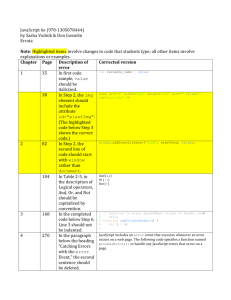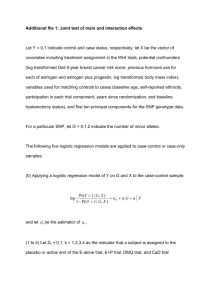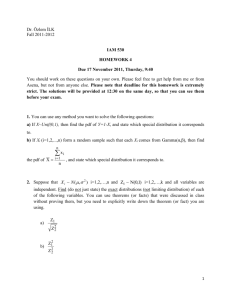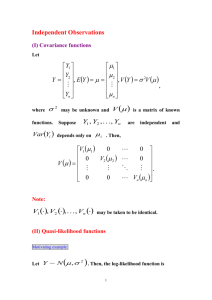Functions and Transformations of Random
advertisement
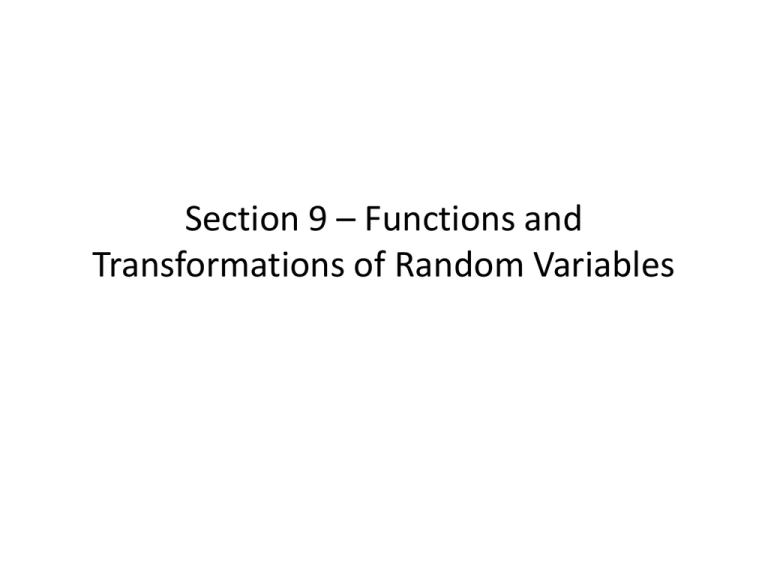
Section 9 – Functions and
Transformations of Random Variables
Distribution of a transformation of
continuous RV: X
• Y = u(X)
– Y is defined as a function “u” of X
• v(u(x))=x
– Function “v” is defined as function the inverse
function of “u”
– Obtain v(u(x)) by solving the given Y=u(x) for x
fY (y) f X (v(y)) | v'(y) |
Distribution of a Sum of RV’s
• If Y = X1 + X2
– E[Y] = E[X1] + E[X2]
– Var[Y] = Var[X1] + Var[X2] + 2Cov[X1, X2]
• Use the
convolution
method to find the
distribution of a
sum of independent
RV’s
– Note: X1 & X2 must
be independent
P[X1 X 2 k]
P[X1 X 2 Y]
k
f (x , x )
1
fY (y)
2
x1 0
f (x1, x 2 )dx1
k
f (x ,k x )
1
1
x1 0
k
f (x ) f (x )
1
1
2
2
x1 0
k
f (x ) f (k x )
1
x1 0
1
2
1
f (x1, y x1 )dx1
f1 (x1 ) f 2 (x 2 )dx1
f1 (x1 ) f 2 (y x1 )dx1
Central Limit Theorem
• If asked for a probability involving a sum of a
large number of independent RV’s, you
usually need to use the normal
approximation
– X1, X2, … Xn are independent RV’s with the same
distribution
• X has mean and standard deviation
E[Yn ] n
Var[Yn ] n 2
Y n~ N(n,n 2 )
Distribution of Maximum or Minimum of a
Collection of Independent RV’s
• Suppose X1 and X2 are independent RV’s
– U = max{X1, X2}
– V = min{X1, X2} (trickier)
– We know F1(x) and F2(x) such that F1(x)=P(X1<=x)
FU (u) P[U u] P[max{X1, X 2} u]
P[(X1 u) (X 2 u)]
(independent)
P[X1 u] P[X 2 u]
F1(u) F2 (u)
FU (u) F1 (u) F2 (u)
FV (v) P[V v] 1 P(V v)
1 P[min{X1, X 2 } v]
1 P[(X1 v) (X 2 v)]
(independent)
1 P[X1 v] P[X 2 v]
1 [1 F1 (v)][1 F2 (v)]
FV (v) 1 [1 F1 (v)][1 F2 (v)]
Mixtures of RV’s
• X1 and X2 are RV’s with independent (but usually different) probability
functions
• X is a mixture of X1 and X2
– Where 0<a<1
– Weight “a” on X1
– Weight (1-a) on X2
• Expectation, probabilities, and moments follow a “weighted-average”
form:
E[X] aE[X ] (1 a)E[X ]
1
2
E[X 2 ] aE[X12 ] (1 a)E[X 22 ]
FX (x) aF1 (x) (1 a)F2 (x)
M X (t) aMX 1 (t) (1 a)M X 2 (t)
• Variance is NOT calculated from a “weighted-average approach”
• Use
the above approach to find E[X] & E[X^2]
Var[X] aVar[X1 ] (1 a)Var[X 2 ]
Var[X] E[X 2 ] (E[X])2
Mixtures of RV’s
• There is a difference between a “sum of RV’s”
and a “mixture of RV’s”
– Sum of RV’s: X = X1 + X2
– Mixture of RV’s: X is defined by probability
function: f (x) a f (x) (1 a) f (x)
X
1
2
• So, don’t make the mistake of thinking:
X = a*X1 + (1-a)*X2 (this is wrong)







